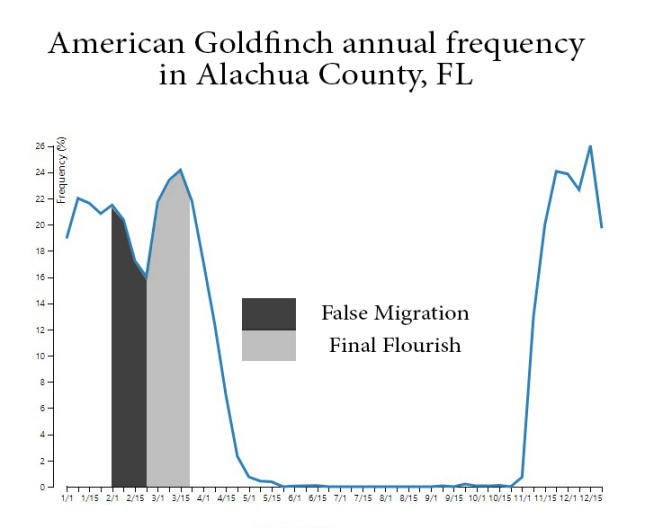American Goldfinches in Alachua County
The chart above represents the annual frequency of American Goldfinch (AMGO) in Alachua County, FL. Read the discussion to understand what's going on with AMGO now and when to anticipate maximum activity at your feeders. As always, watch for Pine Siskins (PISI) among your AMGO. See the short video clip at the bottom of the page for help identifying the PISI among your AMGO.
Late fall to early winter - The Buildup
AMGO begin to arrive in Florida in early November although some "early birds" always straggle into the state as early as September although never in large flocks that stick around at feeders. It is typical in September and October to receive up to a dozen or so localized reports of one or two AMGO visiting a feeder for a day or two. It is exceedingly rare for anyone in this part of the state to establish flock activity before November.
AMGO are largely facultative migrants, meaning individual choose whether or not to migrate. That decision seems to be based upon food availability. So, as overwintering conditions worsen further north in their overwintering range, AMGO push further and further south. Milder conditions and/or more abundant natural food supplies further north mean fewer birds push this far into the southern end of the continent. That's why some winters can produce huge numbers of overwintering AMGO and others produce very few.
False Migration
Beginning in the first half of February, hardwoods begin to bud out in North Central Florida. When they do, AMGO take a break from feeders, return to the hardwood forests, and forage on the tender, budding leaves of various species of hardwood trees. Those hardwoods continue to bud over the next month or so. AMGO continue to favor these natural greens to feeders until the leaves become more fibrous and difficult to digest. At the same time, AMGO begin to molt and fuel up for true migration north back to breeding grounds.
The Final Flourish
Molt and migration are huge energy demands and so the return of AMGO to feeders after the false migration can be dramatic. This is the time of huge flocks - hundreds in rural location in big overwintering years - the members of which seem to be more and more appreciative of feeders. This Final Flourish is one of the most eagerly anticipated events of the year at birdfeeders in the Southeast. This is also the time of year that AMGO finally seem to consume Nyjer seed as readily as they will black oil sunflower and sunflower chips.
True Migration
AMGO finally begin to head north in the second and third week of March. Numbers will have reduced by about 25% by the end of March and by about 50% by mid-April. By the first week of May, almost all of the overwintering AMGO will have departed although some small flocks remain active at a few feeders in mostly rural areas into the second week of May. Occasionally, a single bird will remain into the summer but there are no breeding records of AMGO in Alachua County.


